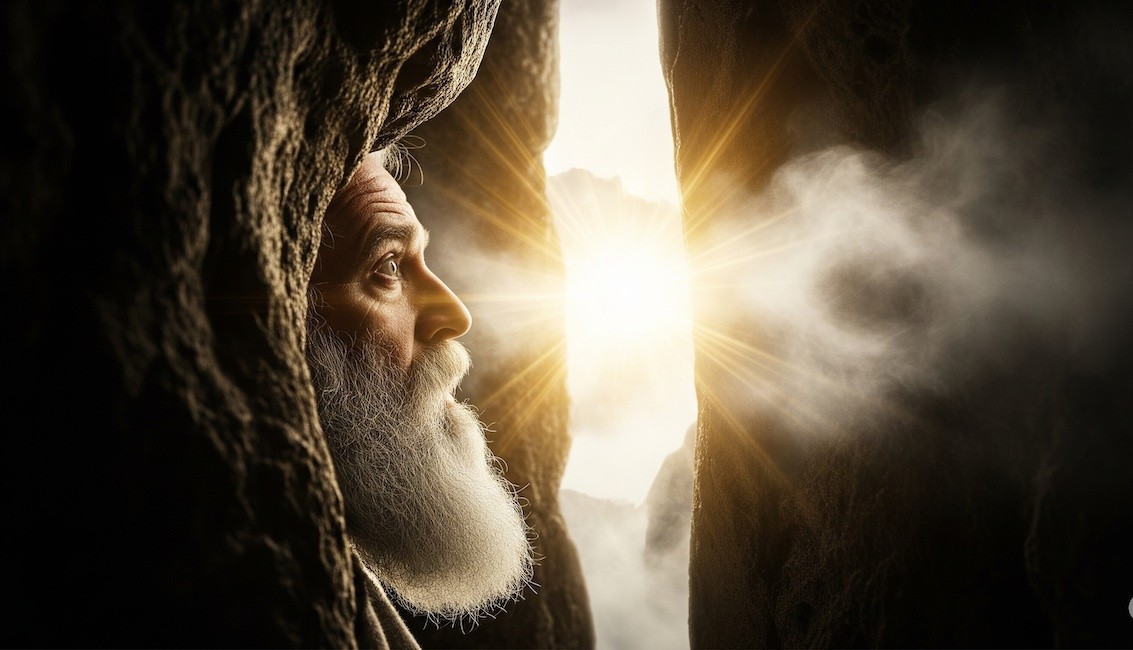Ex. 33: 14, 17-23 (excerpts) – “My presence shall go with thee, and I will give thee rest. …thou has found grace in my sight, and I know thee by name. And he said, I beseech thee, show me thy glory. And he said, I will make all my goodness pass before thee…Thou canst not see my face, for there shall no man see me, and live…Behold, there is a place by me, and thou shalt stand upon a rock…I will put thee in a cleft of the rock, and will cover thee with my hand while I pass by: And I will take away mine hand, and thou shalt see my back parts: but my face shall not be seen.”
This episode occurs after Moses’ return from his forty day sojourn on Mount Sinai during which he received the Law, the Ten Commandments, and instructions on building the Tabernacle. Moses had earlier given an angry response to the people’s sin during his absence (32:19-28). He offered his own life and soul to the Lord in what he hoped to be a sufficient payment for their sin, but God refused to blot his name out of the Book (32:32-33). God would not destroy His friend for other people’s sin. It would not be a sufficient sacrifice, for He knew that one day a greater sacrifice would be offered by His only begotten Son on Calvary. It occurred to Moses at some point that He had just been conversing for the last month or more with Almighty God, yet He had never seen His face. He surely understood that God could see him, but he could not see God. He wanted to know God better.
We read in the New Testament that no man has seen God at any time (Jn. 1:18; I Jn. 4:12). David, too, later wrote that he longed to see God’s face (Ps. 37:8). It is a noble thing to desire to see God’s face, but it simply wasn’t time yet for either Moses or David to see that glorious visage. Yet one day they, and all who are pure in heart, shall see God (Matt. 5:8). But God allowed Moses a special blessing. He was allowed to see God from behind, though he could not see His face. So God hid him in a cleft of a rock, covered his face, and passed by him. Seeing God, even from behind, must have been a sight the great prophet never forgot. No doubt he carried the image in his mind right up to the time he came to rest in the cool tomb of Mount Nebo.
Many years later, in about 1762, a Christian named Augustus M. Toplady wrote a song while being caught in a severe storm along a gorge near Burrington Combe, just outside Burrington, Somerset, England. He took shelter in a gap in the gorge and was reminded of this episode of Moses hidden in the rock. It is said that he wrote the lyrics to what would become an unforgettable hymn during this time. Today one can travel there and read a plaque on the site which describes this episode of how he escaped the storm. The plaque reads: “Rock of Ages: This rock derives its name from the well known hymn written about 1762 by the Rev A. M. Toplady who was inspired whilst sheltering in this cleft during a storm.” Rock of Ages, cleft for me, let me hide myself in thee!
We, today, often wish we could see the face of our Savior, as did Moses and David and countless others who have gone on before. And one day, we who have been covered with the blood of the Son of God, of whom we can only know by looking back – behind, as it were, as He passed by and became man so long ago--will see Him, not from behind, but face to face.
But until then, let us never tire of reading of His wonderful life and deeds and drawing near to Him, even as we draw our fleeting breath. For “thou must save, and thou alone.” He is the Rock of Ages, wounded for us, dying for us, rising again from the grave for us, and one day coming back for us. He will always be a rock for us in a weary land (Isa. 32:2), the chief corner stone of our salvation (Eph. 2:20).
Blessed be His Name.




